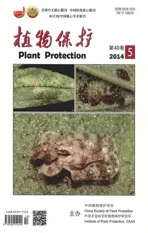警惕番茄褪绿病毒在我国的传播和危害
2014-02-01杨普云赵汝娜师迎春范在丰
周 涛, 杨普云, 赵汝娜, 师迎春, 原 锴, 范在丰
(1. 中国农业大学植物病理学系,北京 100193;2. 全国农业技术推广服务中心,北京 100125;3. 北京市植物保护站,北京 100029;4. 北京市房山区植物保护站,北京 102488)
有害生物动态
警惕番茄褪绿病毒在我国的传播和危害
周 涛1*, 杨普云2, 赵汝娜1, 师迎春3, 原 锴4, 范在丰1
(1. 中国农业大学植物病理学系,北京 100193;2. 全国农业技术推广服务中心,北京 100125;3. 北京市植物保护站,北京 100029;4. 北京市房山区植物保护站,北京 102488)
番茄褪绿病毒(Tomatochlorosisvirus,ToCV)侵染番茄引起番茄褪绿病毒病。发病植株下部叶片黄化、脉间褪绿、边缘轻微卷曲,叶片光合作用显著降低,果实变小,产量和品质明显下降。该病毒最早于1998年在美国佛罗里达州发现,随后在世界多地陆续报道。我国首先于2004年在台湾报道,2013年又在北京和山东发现并鉴定了该病毒,同时在辣椒上检测到该病毒。ToCV属于长线形病毒科(Closteroviridae)毛形病毒属(Crinivirus)成员,基因组为二分体正义单链RNA,由粉虱传播。经初步调查和检测,ToCV在我国北京、山东、河北、天津等省市相继发生,给当地番茄生产造成了严重危害。ToCV传播迅速,成为我国番茄生产中又一重要病毒,防控形势严峻。基于以上原因,建议有关部门立即采取相应预防和防治措施,组织开展相关研究和攻关,控制该病毒在我国的传播和危害。
番茄褪绿病毒; 脉间褪绿; 粉虱; 防治措施
1989年美国佛罗里达州温室栽培的番茄(Solanumlycopersicum)上出现“黄叶紊乱”(yellow leaf disorder)症状,怀疑为生理或营养失调、农药药害或者病毒侵染所致;1998年,该病原被鉴定为番茄褪绿病毒(Tomatochlorosisvirus, ToCV)[1]。ToCV侵染番茄导致番茄叶片脉间黄化,部分区域变红,发育受阻,轻微卷曲,通常在老叶上表现明显,新生枝条和叶片表现正常,随着病害发展,发生脉间坏死,叶片变脆易碎、叶片变厚(图1)。ToCV侵染番茄引起的症状极易与物理损伤、营养失调或农药药害混淆,但典型的症状特点是植株中下部叶片发病,而新生部分正常。
已知有两种长线形病毒侵染番茄引起番茄褪绿病,一种是番茄褪绿病毒(ToCV),一种是番茄侵染性褪绿病毒(Tomatoinfectiouschlorosisvirus, TICV)。ToCV和TICV在番茄上引起症状相同,且均导致植株长势变弱,果实产量降低[2]。我国目前仅发现ToCV。
1 世界分布和在我国的危害
目前,除大洋洲和南极洲未见报道外,其余各洲均报道有ToCV发生。在欧洲,葡萄牙[3]、意大利[4-5]、法国[6]、匈牙利[7]、西班牙[8]和希腊[9]报道有ToCV发生;在北美洲,美国[1]、墨西哥[10]、古巴[11]、哥斯达黎加[12]报道有ToCV的分布;南美洲的巴西[13]报道ToCV发生;在非洲,毛里求斯[14]和苏丹[15]有ToCV的分布;在亚洲,以色列[16]、塞浦路斯[17]、黎巴嫩[18]、土耳其[19]、日本[20]和中国[21-23]均有ToCV的分布。
我国首先在台湾地区报道了ToCV的发生[21],随后在北京[22]、江苏[23]、山东[24]三省市温室栽培的番茄植株上检出ToCV,并且其发病率呈逐渐增长之势。2013年我们在常规蔬菜病毒病调查过程中发现,番茄褪绿病毒病已在山东(寿光、莘县)、河北(唐山、保定)、北京、天津等省市发生,一般田块的发病率高于50%(图2)。采集样品带回实验室进行分子检测,这些样品全部被ToCV侵染(未发表结果)。ToCV已给当地番茄生产造成了严重危害,受害番茄产量降低60%,单价降低50%,成为我国番茄生产中又一重要病毒。
2 分类、基因组和粒子特性
根据国际病毒分类委员会(International Committee on Taxonomy of Viruses,ICTV)第9次分类报告所述,ToCV属于长线形病毒科(Closteroviridae)毛形病毒属(Crinivirus)[25]。ToCV的基因组为二分体正义单链RNA(+ssRNA),RNA的5′端可能有一个甲基化帽子结构,3′端既无Ploy(A),也不形成tRNA样结构,可能形成发夹结构[25]。目前世界上报道了7个分离物的基因组全序列,包括美国分离物[26],西班牙的2个分离物[8,27],希腊分离物[9]、巴西分离物[28],以及中国北京分离物[29]和山东分离物[24]。病毒粒子弯曲长线形,长800~850 nm,直径约为12 nm,呈螺旋对称结构,螺距3.4~3.8 nm[30]。ToCV基因组RNA1和RNA2分别包装在两种不同的病毒粒子中,两者对成功侵染寄主都是必需的。
3 寄主范围
ToCV可以侵染茄科(Solanaceae)、菊科(Compositae)、藜科(Chenopodiaceae)、苋科(Amaranthaceae)、番杏科(Aizoaceae)、夹竹桃科(Apocynaceae)及白花丹科(Plumbaginaceae)等7科25种植物。其中,茄科寄主数目最多,如:番茄(S.lycopersicum)、辣椒(Capsicumannuum)、普通烟(Nicotianatabacum)、本生烟(N.benthamiana)等多种烟草[2]。一些常见杂草和观赏植物也是ToCV的寄主,如苦苣菜(Sonchusoleraceus)、百日菊(Zinniaelegans)、矮牵牛(Petuniahybrida)等。
4 传播方式
ToCV不能通过汁液摩擦传播,其自然传毒介体为粉虱。有4种粉虱能够传播ToCV,但传毒效率差异较大。纹翅粉虱(Trialeurodesabutilonea)和B型烟粉虱(BemisiatabaciB-biotype)的传毒效率较高,A型烟粉虱(B.tabaciA-biotype)和温室白粉虱(T.vaporariorum)的传毒效率则较低。纹翅粉虱带毒长达5 d,B型烟粉虱带毒为2 d,而A型烟粉虱和温室白粉虱只能带毒1 d,虽然传毒效率有差异,但都可以进行有效的传毒[2]。
5 防控措施
目前国际上还未发现对ToCV表现抗性的番茄材料,无抗病品种可以使用。因为ToCV的传播介体为粉虱,使用杀虫剂杀灭粉虱是控制损失的首选方法。因目前我国番茄产区粉虱种群主要为烟粉虱,烟粉虱同时又是番茄黄化曲叶病毒(Tomatoyellowleafcurlvirus,TYLCV)的传播介体,所以可以借鉴番茄黄化曲叶病毒病的防治方法[31]来防治番茄褪绿病毒病。但要注意的是,虽然杀虫剂能够有效控制粉虱群体,但不能有效控制病毒,因为粉虱在被杀死前可能已经传播了病毒。另外,番茄被ToCV侵染后3~4周才表现症状。因此,在观察到症状时病毒已经侵入植株体内,这时再通过控制烟粉虱来防控,效果就不明显了。
清除杂草等ToCV的寄主是控制ToCV的另一项重要措施。ToCV寄主范围中等,其中许多能感染ToCV的杂草在番茄田间和园艺植物附近非常常见。因此清除番茄生产棚室内及周边的其他寄主植物,同时控制传播介体能够降低病毒的扩散和损失。
相比于感染后2~3周发病的番茄黄化曲叶病毒病,ToCV引起的番茄褪绿病毒病潜育期更长,隐蔽性强,容易与缺素症混淆,被发现或鉴定时,已大面积严重发生,造成防治不及时。近几年来,菜农逐渐对番茄黄化曲叶病毒病熟悉,在番茄田间发现病株能即刻拔除,而对番茄褪绿病毒病还没有认识,这也是番茄褪绿病毒病严重发生的重要原因。基于以上原因,建议有关部门立即采取相应预防和防治措施,组织研究单位开展相关研究和攻关,控制ToCV在我国的传播和危害。
[1]Wisler G C, Li R H, Liu H, et al.Tomatochlorosisvirus: a new whitefly-transmitted, phloem-limited, bipartite closterovirus of tomato[J]. Phytopathology,1998,88(5):402-409.
[2]Wintermantel W M, Wisler G C. Vector specificity, host range, and genetic diversity ofTomatochlorosisvirus[J]. Plant Disease. 2006,90(6):814-819.
[3]Louro D, Accotto G P, Vaira A M. Occurrence and diagnosis ofTomatochlorosisvirusin Portugal[J]. European Journal of Plant Pathology, 2000,106(6):589-592.
[4]Accotto G P, Vaira A M, Vecchiati M, et al. First report ofTomatochlorosisvirusin Italy[J]. Plant Disease, 2001,85(11):1208.
[5]Parrella G, Scassillo L. First report ofTomatochlorosisvirus(ToCV) in Campania and ofTomatoinfectiouschlorosisvirus(TICV) in Calabria (Southern Italy)[J]. Informatore Fitopatologico, 2006,56(6):33-34.
[6]Dalmon A, Bouyer S, Cailly M, et al. First report ofTomatochlorosisvirus andTomatoinfectiouschlorosisvirusin tomato crops in France[J]. Plant Disease,2005,89(11):1243.
[7]Bese G, Bóka K, Krizbai L, et al. First report ofTomatochlorosisvirusin tomato from Hungary[J]. Plant Disease,2011,95(3):363.
[8]Lozano G, Moriones E, Navas-Castillo J. Complete nucleotide sequence of the RNA2 of the crinivirusTomatochlorosisvirus[J]. Archives of Virology, 2006,151(3):581-587.
[9]Kataya A, Stavridou E, Farhan K, et al. Nucleotide sequence analysis and detection of a Greek isolate ofTomatochlorosisvirus[J]. Plant Pathology, 2008,57(5):819-824.
[10]Alvarez Ruiz P, Jimenez C G, Leyva López N E, et al. First report ofTomatochlorosisvirusinfecting tomato crops in Sinaloa, Mexico[J]. Plant Pathology,2007,56(6):1043.
[11]Martínez-Zubiaur Y, Fiallo-Olivé E, Carrillo-Tripp J, et al. First report ofTomatochlorosisvirusinfecting tomato in single and mixed infections withTomatoyellowleafcurlvirusin Cuba[J]. Plant Disease,2008,92(5):836.
[12]Vargas J A, Hammond R, Hernandez E, et al. First report ofTomatochlorosisvirusinfecting sweet pepper in Costa Rica[J]. Plant Disease, 2011,95(11):1482.
[13]Barbosa J C, Teixeira A, Moreira A G, et al, First report ofTomatochlorosisvirusinfecting tomato crops in Brazil[J]. Plant Disease, 2008,92(12):1709.
[14]Lett J M, Hoareau M, Reynaud B, et al. First report ofTomatochlorosisvirusin tomato on Mauritius Island[J]. Plant Disease,2009,93(1):111.
[15]Fiallo-Olivé E, Hamed A A, Moriones E, et al. First report ofTomatochlorosisvirusinfecting tomato in Sudan[J]. Plant Disease,2011,95(12):1592.
[16]Segev L, Wintermantel W M, Polston J E, et al. First report ofTomatochlorosisvirusin Israel[J]. Plant Disease,2004,88(10):1160.
[17]Papayiannis L C, Ioannou N, Dovas C I, et al. First report ofTomatochlorosisviruson tomato crops in Cyprus[J]. Plant Pathology,2006,55(4):567.
[18]Abou-Jawdah Y, El Mohtar C, Atamian H, et al. First report ofTomatochlorosisvirusin Lebanon[J]. Plant Disease,2006,90(3):378.
[19]Cevik B, Erkis G. First report ofTomatochlorosisvirusin Turkey[J]. Plant Pathology,2008,57(4):767.
[20]Hirota T, Natsuaki T, Murai T, et al. Yellowing disease of tomato caused byTomatochlorosisvirusnewly recognized in Japan[J]. Journal of General Plant Pathology,2010,76(2):168-171.
[21]Tsai W S, Shih S L, Green S K, et al. First report of the occurrence ofTomatochlorosisvirusandTomatoinfectiouschlorosisvirusin Taiwan[J]. Plant Disease,2004,88(3):311.
[22]Zhao R, Wang R, Wang N, et al. First report ofTomatochlorosisvirusin China[J]. Plant Disease,2013,97(8):1123.
[23]Karwitha M, Feng Z, Yao M, et al. The complete nucleotide sequence of the RNA 1 of a chinese isolate ofTomatochlorosisvirus[J]. Journal of Phytopathology,2014,162(4):411-415.
[24]Zhao L, Li G, Gao Y, et al. Molecular detection and complete genome sequences ofTomatochlorosisvirusisolates from infectious outbreaks in China[J/OL]. Journal of Phytopathology, 2014-02-27. DOI:10.1111/jph.12236.
[25]King A M Q, Adams M J, Carstens E B, et al. Virus taxonomy:ninth report of the international committee on taxonomy of viruses[M]. Amsterdam:Elsevier Academic Press,2011.
[26]Wintermantel W M, Wisler G C, Anchieta A G, et al. The complete nucleotide sequence and genome organization ofTomatochlorosisvirus[J]. Archives of Virology,2005,150(11):2287-2298.
[27]Lozano G, Moriones E, Navas-Castillo J. Complete sequence of the RNA1 of a European isolate ofTomatochlorosisvirus[J]. Archives of Virology,2007,152(4):839-841.
[28]Albuquerque L C, Villanueva F, Resende R O, et al. Molecular characterization reveals BrazilianTomatochlorosisvirusto be closely related to a Greek isolate[J]. Tropical Plant Pathology,2013,38(4):332-336.
[29]Zhao R, Wang N, Wong R, et al. Characterization and full genome sequence analysis of a Chinese isolate ofTomatochlorosisvirus[J]. Acta Virologica,2014,58(1):92-94.
[30]Liu H, Wisler G C, Duffus J E. Particle lengths of whitefly-transmitted criniviruses[J]. Plant Disease,2000,84(7):803-805.
[31]周涛,师迎春,陈笑瑜,等. 北京地区番茄黄化曲叶病毒病的鉴定及防治对策讨论[J]. 植物保护,2010,36(2):116-118.
AlarmingthetransmissionanddamageofTomatochlorosisvirusinChina
Zhou Tao1, Yang Puyun2, Zhao Runa1, Shi Yingchun3, Yuan Kai4, Fan Zaifeng1
(1.DepartmentofPlantPathology,ChinaAgriculturalUniversity,Beijing100193,China; 2.NationalAgro-TechnicalExtensionandServiceCentre,Beijing100125,China; 3.BeijingPlantProtectionStation,Beijing100029,China; 4.FangshanStationofPlantProtection,Beijing102488,China)
Tomatochlorosisvirus(ToCV) causes leaf chlorosis on infected tomato plants. The lower leaves become yellow, interveinal chlorosis, slightly curling on edges, and photosynthesis decreases obviously. The fruits on infected plants turn smaller, and the production and quality are reduced significantly. ToCV was firstly identified in Florida, USA, and then was reported in many countries. In China, ToCV was reported firstly from Taiwan in 2004. In 2013, ToCV was found on tomato plants in Beijing and Shandong Province, and was detected on pepper plants at the same time. Being a member ofCrinivirusin family Closteroviridae, ToCV has a bipartite positive single-stranded RNA, and is transmitted by whitefly. Preliminary survey indicated ToCV had spread in Beijing, Shandong, Hebei and Tianjin, and caused severe damage on local tomato production. As its fast transmission, ToCV has become one of the most important viruses for China’s tomato production. It is suggested that measures must be carried out to perform research on ToCV, and to control its transmission and damage on tomato plants.
Tomatochlorosisvirus; interveinal chlorosis; whitefly; control measures
2014-05-03
:2014-06-03
国家“863”计划项目(2012AA100103)
S 432.41
:BDOI:10.3969/j.issn.0529-1542.2014.05.038
* 通信作者 E-mail: taozhoucau@cau.edu.cn
